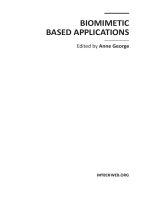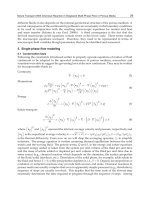Differential Equations and Their Applications Part 1 doc
Bạn đang xem bản rút gọn của tài liệu. Xem và tải ngay bản đầy đủ của tài liệu tại đây (760.68 KB, 20 trang )
Lecture Notes in Mathematics
Editors:
A. Dold, Heidelberg
F. Takens, Groningen
B. Teissier, Paris
1702
Springer
Berlin
Heidelberg
New York
Barcelona
Hong Kong
London
Milan
Paris
Singapore
Tokyo
Jin Ma Jiongmin Yong
Forward-Backward
Stochastic
Differential Equations
and Their Applications
Springer
Authors
Jin Ma
Department of Mathematics
Purdue University
West Lafayette, IN 47906-1395
USA
e-mail: majin @ math.purdue.edu
Jiongmin Yong
Department of Mathematics
Fudan University
Shanghai, 200433, China
e-mail:
Cataloging-in-Publication Data applied for
Die Deutsche Bibliothek - CIP-Einheitsaufnahme
Ma, Jin:
Foreward backward stochastic differential
equations and their
applications / Jin Ma ; Jiongmin Yong. - Berlin, Heidelberg ; New
York ; Barcelona ; Hong Kong ; London ; Milan, Paris ; Singapore,
Tokyo : Springer, 1999
(Lecture notes in mathematics ; 1702)
ISBN
3-540-65960-9
Mathematics Subject Classification (1991): Primary: 60H10, 15, 20, 30; 93E03;
Secondary: 35K15, 20, 45, 65; 65M06, 12, 15, 25; 65U05; 90A09, 10, 12, 16
ISSN 0075-8434
ISBN 3-540-65960-9 Springer-Verlag Berlin Heidelberg New York
This work is subject to copyright. All rights are reserved, whether the whole or part
of the material is concerned, specifically the rights of translation, reprinting, re-use
of illustrations, recitation, broadcasting, reproduction on microfilms or in any other
way, and storage in data banks. Duplication of this publication or parts thereof is
permitted only under the provisions of the German Copyright Law of September 9,
1965, in its current version, and permission for use must always be obtained from
Springer-Verlag. Violations are liable for prosecution under the German Copyright
Law.
9 Springer-Verlag Berlin Heidelberg 1999
Printed in Germany
The use of general descriptive names, registered names, trademarks, etc. in this
publication does not imply, even in the absence of a specific statement, that such
names are exempt from the relevant protective laws and regulations and theretbre
free for general use.
Typesetting: Camera-ready TEX output by the authors
SPIN: 10650174 41/3143-543210 - Printed on acid-free paper
To
Yun and Meifen
Preface
This book is intended to give an introduction to the theory of forward-
backward stochastic differential equations (FBSDEs, for short) which has
received strong attention in recent years because of its interesting structure
and its usefulness in various applied fields.
The motivation for studying FBSDEs comes originally from stochastic
optimal control theory, that is, the adjoint equation in the Pontryagin-type
maximum principle. The earliest version of such an FBSDE was introduced
by Bismut [1] in 1973, with a decoupled form, namely, a system of a usual
(forward) stochastic differential equation and a (linear) backward stochastic
differential equation (BSDE, for short). In 1983, Bensoussan [1] proved the
well-posedness of general linear BSDEs by using martingale representation
theorem. The first well-posedness result for nonlinear BSDEs was proved
in 1990 by Pardoux-Peng [1], while studying the general Pontryagin-type
maximum principle for stochastic optimal controls. A little later, Peng [4]
discovered that the adapted solution of a BSDE could be used as a prob-
abilistic interpretation of the solutions to some semilinear or quasilinear
parabolic partial differential equations (PDE, for short), in the spirit of the
well-known Feynman-Kac formula. After this, extensive study of BSDEs
was initiated, and potential for its application was found in applied and the-
oretical areas such as stochastic control, mathematical finance, differential
geometry, to mention a few.
The study of (strongly) coupled FBSDEs started in early 90s. In his
Ph.D thesis, Antonelli [1] obtained the first result on the solvability of an
FBSDE over a "small" time duration. He also constructed a counterexam-
ple showing that for coupled FBSDEs, large time duration might lead to
non-solvability. In 1993, the present authors started a systematic investiga-
tion on the well-posedness of FBSDEs over arbitrary time durations, which
has developed into the main body of this book. Today, several methods have
been established for solving a (coupled) FBSDE. Among them two are con-
sidered effective: the Four Step Scheme by Ma-Protter-Yong [1] and the
Method of Continuation by Hu-Peng [2], and Yong [1]. The former provides
the explicit relations among the forward and backward components of the
adapted solution via a quasilinear partial differential equation, but requires
the non-degeneracy of the forward diffusion and the non-randomness of the
coefficients; while the latter relaxed these conditions, but requires essen-
tially the "monotonicity" condition on the coefficients, which is restrictive
in a different way.
The theory of FBSDEs have given rise to some other problems that are
interesting in their own rights. For example, in order to extend the Four
Step Scheme to general random coefficient case, it is not hard to see that
one has to replace the quasilinear parabolic PDE there by a quasilinear
backward stochastic partial differential equation (BSPDE for short), with a
viii Preface
strong degeneracy in the sense of stochastic partial differential equations.
Such BSPDEs can be used to generalize the Feynman-Kac formula and even
the Black-Scholes option pricing formula to the case when the coefficients of
the diffusion are allowed to be random. Other interesting subjects generated
by FBSDEs but with independent flavors include FBSDEs with reflecting
boundary conditions as well as the numerical methods for FBSDEs. It is
worth pointing out that the FBSDEs have also been successfully applied to
model and to resolve some interesting problems in mathematical finance,
such as problems involving term structure of interest rates (consol rate
problem) and hedging contingent claims for large investors, etc.
The book is organized as follows. As an introduction, we present several
interesting examples in Chapter 1. After giving the definition of solvabil-
ity, we study some special FBSDEs that are either non-solvable or easily
solvable (e.g., those on small durations). Some comparison results for both
BSDE and FBSDE are established at the end of this chapter. In Chapter
2 we content ourselves with the linear FBSDEs. The special structure of
the linear equations enables us to treat the problem in a special way, and
the solvability is studied thoroughly. The study of general FBSDEs over
arbitrary duration starts from Chapter 3. We present virtually the first
result regarding the solvability of FBSDE in this generality, by relating the
solvability of an FBSDE to the solvability of an optimal stochastic control
problem. The notion of
approximate solvability
is also introduced and de-
veloped. The idea of this chapter is carried on to the next one, in which
the Four Step Scheme is established. Two other different methods leading
to the existence and uniqueness of the adapted solution of general FBSDEs
are presented in Chapters 6 and 7, while in the latter even reflections are
allowed for both forward and backward equations. Chapter 5 deals with a
class of linear backward SPDEs, which are closely related to the FBSDEs
with random coefficients; Chapter 8 collects some applications of FBSDEs,
mainly in mathematical finance, which in a sense is the inspiration for much
of our theoretical research. Those readers needing stronger motivation to
dig deeply into the subject might actually want to go to this chapter first
and then decide which chapter would be the immediate goal to attack.
Finally, Chapter 9 provides a numerical method for FBSDEs.
In this book all "headings" (theorem, lemma, definition, corollary, ex-
ample, etc.) will follow a single sequence of numbers within one chapter
(e.g., Theorem 2.1 means the first "heading" in Section 2, possibly followed
immediately by Definition 2.2, etc.). When a heading is cited in a different
chapter, the chapter number will be indicated. Likewise, the numbering
for the equations in the book is of the form, say, (5.4), where 5 is the sec-
tion number and 4 is the equation number. When an equation in different
chapter is cited, the chapter number will precede the section number.
We would like to express our deepest gratitude to many people who
have inspired us throughout the past few years during which the main
body of this book was developed. Special thanks are due to R. Buck-
dahn, J. Cvitanic, J. Douglas Jr., D. Duffle, P. Protter, with whom we
Preface ix
enjoyed wonderful collaboration on this subject; to N. E1 Karoui, J. Jacod,
I. Karatzas, N. V. Krylov, S. M. Lenhart, E. Pardoux, S. Shreve, M. Soner,
from whom we have received valuable advice and constant support. We
particularly appreciate a special group of researchers with whom we were
students, classmates and colleagues in Fudan University, Shanghai, China,
among them: S. Chen, Y. Hu, X. Li, S. Peng, S. Tang, X. Y. Zhou. We also
would like to thank our respective Ph.D. advisors Professors Naresh Jain
(University of Minnesota) and Leonard D. Berkovitz (Purdue University)
for their constant encouragement.
JM would like to acknowledge partial support from the United States
National Science Fundation grant #DMS-9301516 and the United States
Office of Naval Research grant #N00014-96-1-0262; and JY would like to
acknowledge partial support from Natural Science Foundation of China, the
Chinese Education Ministry Science Foundation, the National Outstanding
Youth Foundation of China, and Li Foundation at San Francisco, USA.
Finally, of course, both authors would like to take this opportunity to
thank their families for their support, understanding and love.
Jin Ma, West Lafayette
Jiongmin Yong, Shanghai
January, 1999
Contents
Preface vii
Chapter 1. Introduction 1
w Some Examples 1
w A first glance 1
w A stochastic optimal control problem 3
w Stochastic differential utility 4
w Option pricing and contingent claim valuation 7
w Definitions and Notations 8
w Some Nonsolvable FBSDEs 10
w Well-posedness of BSDEs 14
w Solvability of FBSDEs in Small Time Durations 19
w Comparison Theorems for BSDEs and FBSDEs 22
Chapter 2. Linear Equations 25
w Compatible Conditions for Solvability 25
w Some Reductions 30
w Solvability of Linear FBSDEs 33
w Necessary conditions 34
w Criteria for solvability 39
w A Riccati Type Equation 45
w Some Extensions 49
Chapter 3. Method of Optimal Control 51
w Solvability and the Associated Optimal Control Problem 51
w An optimal control problem 51
w Approximate Solvability 54
w Dynamic Programming Method and the HJB Equation 57
w The Value Function 60
w Continuity and semi-concavity 60
w Approximation of the value function 64
w A Class of Approximately Solvable FBSDEs 69
w Construction of Approximate Adapted Solutions 75
Chapter 4. Four Step Scheme 80
w A Heuristic Derivation of Four Step Scheme 80
w Non-Degenerate Case Several Solvable Classes 84
w A general case 84
w The case when h has linear growth in z 86
w The case when m : 1 88
w Infinite Horizon Case 89
xii Contents
w The nodal solution 89
w Uniqueness of nodal solutions 92
w The limit of finite duration problems 98
Chapter 5. Linear, Degenerate Backward Stochastic
Partial Differential Equations 103
w Formulation of the Problem 103
w Well-posedness of Linear BSPDEs 106
w Uniqueness of Adapted Solutions 111
w Uniqueness of adapted weak solutions 111
w An It5 formula 113
w Existence of Adapted Solutions 118
w A Proof of the Fundamental Lemma 126
w Comparison Theorems 130
Chapter 6. The Method of Continuation 137
w The Bridge 137
w Method of Continuation 140
w The solvability of FBSDEs linked by bridges 140
w A priori estimate 143
w Some Solvable FBSDEs 148
w A trivial FBSDE 148
w Decoupled FBSDEs 149
w FBSDEs with monotonicity conditions 151
w Properties of Bridges 154
w Construction of Bridges 158
w A general consideration 158
w A one dimensional case
161
Chapter 7. FBSDEs with Reflections 169
w Forward SDEs with Reflections 169
w Backward SDEs with Reflections 171
w Reflected Forward-Backward SDEs
181
w A priori estimates 182
w Existence and uniqueness of the adapted solutions 186
w A continuous dependence result 190
Chapter 8. Applications of FBSDEs 193
w An Integral Representation Formula 193
w A Nonlinear Feynman-Kac Formula 197
w Black's Consol Rate Conjecture 201
w Hedging Options for a Large Investor 207
w Hedging without constraint 210
w Hedging with constraint 219
w A Stochastic Black-Scholes Formula 226
Contents xiii
w Stochastic Black-Scholes formula 227
w The convexity of the European contingent claims 229
w The robustness of Black-Scholes formula 231
w An American Game Option 232
Chapter 9. Numerical Methods for FBSDEs 235
w Formulation of the Problem 235
w Numerical Approximation of the Quasilinear PDEs 237
w A special case 237
w Numerical scheme 238
w Error analysis 240
w The approximating solutions {u(n)}~=l 244
w General case 245
w Numerical scheme 247
w Error analysis 248
w Numerical Approximation of the Forward SDE 250
Comments and Remarks 257
References 259
Index 269
Chapter
1
Introduction
w Some Examples
To introduce the ]orward-backward stochastic differential equations (FBS-
DEs, for short), let us begin with some examples. Unless otherwise speci-
fled, throughout the book, we let (~, •, {Ft)t_>0, P) be a complete filtered
probability space on which is defined a d-dimensional standard Brownian
motion W(t), such that {5~t }t_>0 is the natural filtration of W(t), augmented
by all the P-null sets. In other words, we consider only the Brownian ill-
tration throughout this book.
w A first glance
One of the main differences between a stochastic differential equation (SDE,
for short) and a (deterministic) ordinary differential equation (ODE, for
short) is that one cannot reverse the "time". The following is a simple
but typical example. Suppose that d 1 (i.e., the Brownian motion is
one-dimensional), and consider the following (trivial) differential equation:
(1.1) dY(t) = O, t C [0, T],
where T > 0 is a given terminal time. For any ~ E R we can require
either Y(0) = ~ or Y(T) = ~ so that (1.1) has a unique solution Y(t) - ~.
However, if we consider (1.1) as a stochastic differential equation (with
null drift and diffusion coefficients) in ItS's sense, things will become a
little more complicated. First note that a solution of an It5 SDE has to
be {gct}t_>0-adapted. Thus specifying Y(0) and Y(T) will have essential
difference. Consider again (1.1), but as a terminal value problem:
dY(t) = 0, t e [0, T],
(1.2) Y(T) = ~,
where ~ E L~%(gt; IR), the set of all S-T-measurable square integrable ran-
dora variables. Since the only solution to (1.2) is Y(t) - ~, Vt E [0, T],
which is not necessarily {~-t)t>_0-adapted unless ~ is a constant, the equa-
tion (1.2), viewed as an It5 SDE, does not have a solution in general!
Intuitively, there are two ways to get around with this difficulty: (1)
modify (or even remove) the adaptedness of the solution in its definition;
(2) reformulate the terminal value problem of an SDE so that it may al-
low a solution which is {~-t}t_>0-adapted. We note here that method (1)
requires techniques such as new definitions of a backward It5 integral, or
more generally, the so-called anticipating stochastic calculus. For more on
the discussion in that direction, one is referred to the books of, say, Kunita
2 Chapter 1. Introduction
[1] and Nualart [1]. In this book, however, we will content ourselves with
method (2), because of its usefulness in various applications as we shall see
in the following sections.
To reformulate (1.2), we first note that a reasonable way of modifying
the solution Y(t) = ~ so that it is {Srt)t_>o-adapted and satisfies Y(T) =
is to define
(1.3) Y(t) ~= E{~[Svt), t G [0, T].
Let us now try to derive, if possible, an (ITS) SDE that the process Y(.)
might enjoy. An important ingredient in this derivation is the Martingale
Representation Theorem (cf. e.g., Karatzas-Shreve [1]), which tells us that
if the filtration
{-~t}t_>0
is
Brownian, then every square integrable martin-
gale M with zero expectation can be written as a stochastic integral with
a unique integrand that is {Jzt}t>_o-progressively measurable and square
integrable. Since the process Y(.) defined by (1.3) is clearly a square inte-
grable {Srt)t>o-martingale, an application of the Martingale Representation
Theorem leads to the following representation:
f0 t
(1.4) Y(t) = Y(O) + Z(s)dW(s), Vte [0, T], a.s.,
where Z(-) E L~(0, T; ~), the set of all {SL-t}t_>0-adapted square integrable
processes. Writing (1.4) in a differential form and combining it with (1.3)
(note that ~ is UT-measurable), we have
(1.5)
dY(t) =/(t)dW(t),
Y(T) = .
t e [0, T],
In other words, if we reformulate (1.2) as (1.5); and more importantly,
instead of looking for a single {~-t}t_>0-adapted process Y(.) as a solution
to the SDE, we look for a pair (Y(.), Z(-)) (although it looks a little strange
at this moment), then finding a solution which is {Svt)t>0-adapted becomes
possible! It turns out, as we shall develop in the rest of the book, that
(1.5) is the appropriate reformulation of a terminal value problem (1.2)
that possesses an adapted solution (Y,Z). Adding the extra component
Z(-) to the solution is the key factor that makes finding an adapted solution
possible.
As was traditionally done in the SDE literature, (1.5) can be written
in an integral form, which can be deduced as follows. Note from (1.4) that
(1.6)
fo r fo r
Y(O) = Y(T) - Z(s)dW(s) = ~ - Z(s)dW(s).
Plugging (1.6) into (1.4) we obtain
fo'
(1.7) Y(t) = Y(O) + Z(s)dW(s) = ~- Z(s)dW(s), Vt E [0, T].
w Some examples 3
In the sequel, we shall not distinguish (1.5) and (1.7); each of them is called
a backward stochastic differential equation
(BSDE, for short). We would like
to emphasize that the stochastic integral in (1.7) is the usual (forward) It6
integral.
Finally, if we apply It6's formula to
IY(t)l 2
(here I" I denotes the usual
Euclidean norm, see w then
(1.8) EISI 2
EIY(t)I 2 + EIZ(s)12ds, Vte
[0,T].
Thus ~ = 0 implies that Y _ 0 and Z 0. Note that equation (1.7) is
linear, relation (1.8) leads to the uniqueness of the {~t}t>0-adapted solution
(Y(-), Z(.)) to (1.7). Consequently, if ~ is a non-random constant, then by
uniqueness we see that
Y(t) =_ ~
and
Z(t) =_ 0
is the only solution of
(1.7), as we expect. In the following subsections we give some examples
in stochastic control theory and mathematical finance that have motivated
the study of the backward and forward-backward SDEs.
w A stochastic optimal control problem
Consider the following controlled stochastic differential equation:
dX(t) = [aX(t) + bu(t)]dt + dW(t), t e
[0, T],
(1.9) (x(0) = x,
where X(.) is called the
state process, u(.)
is called the
control process.
Both of them are required to be {:Tt}t_>0-adapted and square integrable.
For simplicity, we assume X, u and W are all one-dimensional, and a and
b are constants. We introduce the so-called
cost functional
as follows:
//
An
optimal control problem
is then to minimize the cost functional (1.10)
subject to the
state equation
(1.9). In the present case, it can be shown
that there exists a unique solution to this optimal control problem (in fact,
the mapping
u ~ J(u)
is convex and coercive). Our goal is to determine
this optimal control.
Suppose u(-) is an optimal control and X(.) is the corresponding (opti-
mal) state process. Then, for any admissible control v(.) (i.e., an {~t}t>o-
adapted square integrable process), we have
J(u 4- ~v) - J(u)
0<_
c
(1.11)
+ 0,
where ~(.) satisfies the following
variational system:
f d~(t)
= [a~(t) 4-
bv(t)]dt, t 9
[O,T],
(1.12)
L ,~(o) = o.
4 Chapter 1. Introduction
In order to get more information from (1.11), we introduce the following
adjoint equation:
dY(t) = -[aY(t) + X(t)]dt + Z(t)dW(t), t e [O,T],
(1.13)
Y(T) = X(T).
and we require that the processes Y(-) and Z(.) both be {Srt}t>o-adapted.
It is clear that (1.13) is a BSDE with a more general form than the one we
saw in w since Y(.) is specified at t = T, and
X(T)
is ~rT-measurable in
general.
Now let us assume that (1.13) admits an adapted solution (Y(.), Z(.)).
Then, applying ItS's formula to
Y(t)~(t),
one has
E IX (T)~(T)] = E [Y(T)~(T)]
/o
= E { [ - aY(t) -
X(t)] ~(t) +
Y(t)[a~(t)
+
bv(t)] }dt
(1.14)
= E [- X(t)~(t) + bY(t)v(t)]dt.
Hence, (1.11) becomes
(1.15)
0 <_ E [bY(t) + u(t)]v(t)dt.
Since v(.) is arbitrary, we obtain that
(1.16)
u(t) = -bY(t),
a.e.t C [0,T], a.s.
We note that since Y(.) is required to be {~ct}t_>o-adapted, the process
u(.) is an
admissible
control (this is why we need the adapted solution for
(1.13)!). Substituting (1.16) into the state equation (1.9), we finally obtain
the following
optimality system:
dX(t) = laX(t) - b2Y(t)]dt + dW(t),
t e [0, T],
(1.17)
dY(t) = -[aY(t) + X(t)]dt + Z(t)dW(t),
X(O) = x, Y(T) = X(T).
We see that the equation for X(.) is
forward
(since it is given the initial
datum) and the equation for Y(-) is
backward
(since it is given the final
datum). Thus, (1.17) is a
coupled forward-backward stochastic differential
equation
(FBSDE, for short). It is clear that if we can prove that (1.17)
admits an adapted solution (X(-), Y(.), Z(.)), then (1.16) gives an optimal
control, solving the original stochastic optimal control problem. Further, if
the adapted solution (X(.), Y(.), Z(.)) of (1.17) is unique, so is the optimal
control u(-).
w Stochastic differential utility
Two of the most remarkable applications of the theory of BSDEs (a spe-
cial case of FBSDEs) in finance theory have been the stochastic differential
w Some examples 5
utility and the contingent claim valuation. In this and the following sub-
sections, we describe these problems from the perspective of FBSDEs.
Stochastic differential utility
is an extension of the notion of
recursive
utility
to a continuous-time, stochastic setting. In the simplest discrete, de-
terministic model (see, e.g., Koopmans [1]), the problem of recursive utility
is to find certain utility functions that satisfy a recursive relation. For ex-
ample, assume that the consumption plans are denoted by c = {Co,
cl,"
"},
where
ct
represents the consumption in period t, and the
current utility
is
denoted by Vt, then we say that V = {Vt : t = 0, 1, } defines a recursive
utility if the sequence V0, V1, satisfies the recursive relation:
(1.18)
Vt
=
W(ct,
Vt+l), t = 0, 1,'",
where the function W is called the
aggregator.
We should note that in
(1.18), the recursive relation is
backwards.
The problem can also be stated
as finding a utility function U defined on the space of consumption plans
such that, for any t = 0, 1, , it holds that Vt = U({ct, Ct+l,'' "}), where V
satisfies (1.18). In particular, the utility function U can be simply defined
by U({c0, cl, }) = V0, once (1.18) is solved.
In the continuous-time model one often describes the consumption plan
by its
rate
c = {c(t) : t _> 0}, where
c(t) >_ O, Vt >_ 0
(hence the accumulate
consumption up to time t is
ft c(s)ds).
The
current utility
is denoted by
Y(t) ~= U({c(s) : s >__
t}), and the recursive relation (1.18) is replaced by a
differential equation:
(1.19)
dY(t)
dt - -f(c(t),Y(t)),
where the function f is the
aggregator.
We note that the negative sign in
front of f reflects the time-reverse feature seen in (1.18). Again, once a
solution of (1.19) can be determined, then
U(c)
= Y(0) defines a unitiliy
function.
An interesting variation of (1.18) and (1.19) is their
finite horizon
ver-
sion, that is, there is a
terminal
time T > 0, such that the problem is re-
stricted to 0 < t < T. Suppose that the utility of the terminal consumption
is given by
u(c(T))
for some prescribed utility function u, then the (back-
ward) difference equation (1.18) with terminal condition
VT = u(c(T))
can
be solved uniquely. Likewise, we may pose (1.19), the continuous counter-
part of (1.18), as a terminal value problem with given
Y(T) = u(c(T)),
or
equivalently,
/,
T
(1.20)
Z(t) = u(c(T)) +/t f(c(s), Y(s))ds, t C
[0,T].
In a stochastic model (model with uncertainty) one assumes that both
consumption c and utility Y are stochastic processes, defined on some (fil-
tered) probability space (~, ~', {gvt}t_>o, P). A standard setting is that at
any time t _> 0 the consumption rate
c(t)
and the current utility
Y(t)
can
only be determined by the information up to time t. Mathematically, this
6 Chapter 1. Introduction
axiomatic assumption amounts to saying that the processes c and Y are
both adapted to the filtration {~'t}t>0- Let us now consider (1.20) again,
but bearing in mind that c and Y are {~-t}t>0-adapted processes. Taking
conditional expectation on both sides of (1.20), we obtain
for all t E [0, T]. In the special case when the filtration is generated by a
given Brownian motion W, just as we have assumed in this book, we can
apply the Martingale Representation Theorem as before to derive that
(1.22)
Y(t) = u(c(T)) + f(c(s), Y(s))ds - Z(s)dWs, t e
[0, T].
That is, (Y,Z) satisfies the BSDE (1.22). A more general BSDE that
models the recursive utility is one in which the aggregator f depends also
on Z. The following situation more or less justifies this point. Let U be
another utility function such that U = W o U for some C 2 function ~ with
~'(x) > 0, Vx (in this case we say that U and U are
ordinally equivalent).
Let us define
ft = ~ o u, Y(t) = ~(Y(t) ), Z(t) = ~'(Y(t))Z(t),
and
~gH (Cp 1 (y))
/(c,y,z) = ~'(~9 1(y))f(c,~-l(y))
~pt(~ l(y)) Z.
Then an application of It6's formula shows that (Y, Z) satisfies the BSDE
(1.22) with a new terminal condition
g(c(T))
and a new aggregator/, which
now depends on z.
The BSDE (1.22) can be turned into an FBSDE, if the consumption
plan depends on other random sources which can be described by some
other (stochastic) differential equations. The following scenario, studied by
Duffie-Ceoffard-Skiadas [1], should be illustrative. Consider m agents shar-
ing a total endowment in an economy. Assume that the total endowment,
denoted by e, is a continuous, non-negative, {~t}t>.0-adapted process; and
that each agent has his own consumption process c * and utility process Y~
satisfying
(1.23)
Yi(t) = ui(ci(T)) + ff(ci(s),Yi(s))ds + Zi(s)dW(s),
for t E [0, T]. For a given
weight vector
a E R~, we say that an
allocation
ca = (c~, , c m) is
a-eJ]icient
if
m m m
a i
(1.24) E
,Ui(c~) :sup
{Ea'U'(c')]Ec'(t)
<_ e(t), t E
[0, T],a.s.},
i=1 i=1 i=1
where
Ui(c ~) = Yi(O).
It is conceivable that the a-efficient allocation ca is no longer an in-
dependent process. In fact, using techniques of non-linear programming
w Some examples 7
it can be shown that, under certain technical conditions on the aggrega-
tors ff's and the terminal utility functions
ui's,
the process ca takes the
form:
ca(t)
= K(A(t),e(t),Y(t)), for some ~m-valued function K, and
A = (A1, , Am), derived from a first-order necessary condition of the op-
timization problem (1.24), satisfies the differential equation:
(1.25)
d)~i(t) = Ai(t)bi(t, A(t),Y(t))dt; t e
[0, T],
with
bi(t,A,y,w)
= ~ Thus (1.23) and (1.25)form
y" c=(K~(X,e(t,w),y))"
an FBSDE.
w Option pricing and contingent claim valuation
In this subsection we discuss option pricing problems in finance and their
relationship with FBSDEs. Consider a security market that contains, say,
one bond and one stock. Suppose that their prices are subject to the
following system of stochastic differential equations:
dPo (t) = r(t)Po (t)dt,
(bond);
(1.26)
dP(t) = P(t)b(t)dt + P(t)a(t)dW(t),
(stock),
where r(.) is the
interest rate
of the bond, b(-) and a(.) are the
appreciation
rate
and
volatility
of the stock, respectively.
An
option
is by definition a contract which gives its holder the right to
sell or buy the stock. The contract should contain the following elements:
1) a specified price q (called the
exercise price,
or
striking price);
2) a terminal time T (called the
maturity date
or
expiration date);
3) an exercise time.
In this book we are particularly interested
European options,
which
specify the exercise time to be exactly equal to T, the maturity date. Let
us take the European
call
option (which gives its holder the right to buy)
as an example. The decision of the holder will depend, conceivably, on
P(T), the stock price at time T. For instance, if
P(T)
< q, then the
holder would simply discard the option, and buy the stock directly from
the market; whereas if
P(T) > q,
then the holder should opt to exercise the
option to make profit. Therefore the total payoff of the writer (or seller) of
the option at time t = T will be
(P(T) -
q)+, an 9rT-measurable random
variable. The (option pricing) problem to the seller (and buyer alike) is
then how to determine a premium for this contract at present time t = 0.
In general, we call such a contract an
option
if the payoff at time t = T can
be written explicitly as a function of
P(T)
(e.g.,
(P(T) - q)+).
In all the
other cases where the payoff at time t = T is just an ~T-mea,surable random
variable, such a contract is called a
contingent claim,
and the corresponding
pricing problem is then called
contingent claim valuation problem.
Now suppose that the agent sells the option at price y and then invests
it in the market, and we denote his total wealth at each time t by
Y(t).
Obviously, Y(0) = y. Assume that at each time t the agent invests a
portion of his wealth, say ~r(t), called
portfolio,
into the stock, and puts
8 Chapter 1. Introduction
the rest
(Y(t) - ~r(t))
into the bond. Also we assume that the agent can
choose to consume so that the cumulative
consumption
up to time t is
C(t),
an
{J:t}t>_o-adapted,
nondecreasing process. It can be shown that the
dynamics of Y(.) and the
port/olio/consumption
process pair (~(.), C(-))
should follow an SDE as well:
dY(t) = {r(t)Y(t) + Z(t)O(t)}dt + Z(t)dW(t) - dC(t),
(1.27) Y(0) = y,
where
Z(t) = 7c(t)a(t),
and 0(t)~
r -
r(t)] (called
risk premium
process). For any contingent claim H E L~%(~,IR), the purpose of the
agent is to choose such a pair (7c, C) as to come up with enough money
to "hedge" the payoff H at time t = T, that is,
Y(T) >_ H.
Such a
consumption/investment pair, if exist, is called a
hedging strategy against
H. The
fair price
of the contingent claim is the smallest initial endowment
for which the hedging strategy exists. In other words, it is defined by
(1.28) y* = inf{y = Y(0); 3(7r, C), such that
Y~'C(T) >_ g}.
Now suppose H =
g(P(T)),
and consider an agent who is so prudent that
he does not consume at all (i.e., C - 0), and is able to choose 7r so that
Y(T) = H = g(P(T)).
Namely, he chooses Z (whence ~r) by solving the
following combination of (1.26) and (1.27):
dP(t) = P(t)b(t)dt + P(t)cr(t)dW(t),
(1.29)
dY(t) = {r(t)Y(t) + Z(t)O(t)}dt + Z(t)dW(t),
P(O) = p, Y(T) = g(P(T)),
which is again an FBSDE (an
decouped
FBSDE, to be more precise). An
interesting result is that if (1.29) has an adapted solution (]I,
Z),
then the
pair (2r, 0), where 7c =
Za -1,
is the optimal hedging strategy and y = Y(0)
is the fair price! A more complicated case in which we allow the interaction
between the agent's wealth/strategy and the stock price will be studied
in details in Chapter 8. In that case (1.29) will become a truly coupled
FBSDE.
w Definitions and Notations
In this sections we list all the notations that will be frequently used through-
out the book, and give some definitions related to FBSDEs.
Let Rn be the n-dimensional Euclidean space with the usual Euclidean
norm
I" [
and the usual Euclidean inner product (.,.). Let ~mxd be the
Hilbert space consisting of all (mx d)-matrices with the inner product
(2.1)
(A,B)~=tr{ABT}, VA, B E lR "~xd.
Thus, the norm I A] of A induced by inner product (2.1) is given by IAI =
x/tr
{AAT}.
Another natural norm for A C ]R "~xd could be taken as
w Definitions and notations 9
I]All ~
~/maxa(AA T)
if we regard A as a linear operator from IR m to ~t d,
where
a(AA T)
is the set of all eigenvalues of
AA T.
It is clear that the
norms I' I and II" I] are equivalent since
Rm•
is a finite dimensional space.
In fact, the following relations hold:
(2.2) ]]A][ _< v/tr
{AA T}
= [A[ < x/ram A d[]A[I, VA E
R ~xa,
where m A d = rain{m, d). We will see that in our later discussions, the
norm ]. ] in
R mxa
induced by (2.1) is more convenient.
Next, we let T > 0 be fixed and (~, ;T, {Yt}t_>o, P) be as assumed at
the beginning of w We denote
9 for any sub-a-field G of f, L~(f~; IR m) to be the set of all G-measurable
Rm-valued square integrable random variables;
9
L~:(f~; L2(0, T; Rn)) to be the set of all {Y't}t>o-progressively measur-
able processes X(.) valued in IR n such that
fo T EIX(t)12dt
< c~. The
notation L~:(0,T;]R '~) is often used for simplicity, when there is no
danger of confusion.
9 L2(f~;C([0, T];~n)) to be the set of all {~-t)t_>o-progressively mea-
surable continuous processes X(-) taking values in Rn, such that
Esupte[O,T]
]X(t)l 2
<
(x).
Also, for any Euclidean spaces M and N, we let
9 L~(O,T;WI'~176
be the set of all functions f : [0, T] x M x
fl + N, such that for any fixed
0 E M, (t,w) ~+ f(t,O;w)
is {~t}t_>0-
progressively measurable with
f(t,
O; w) E L~(O, T; N), and there exists
a constant L > O, such that
If(t,0;w) - f(t,0;~)] <_
LIO- 0[, VO,-O E M,
a.e.t E [0,T], a.s.;
9 L~r(~;Wl'~176
be the set of all functions g:]R n • ~ ~ ]R m,
such that
w w~, g(x; w)
is 5~T-measurable for all x E R'~ and
x ~+ g(x; w)
is uniformly Lipschitz in x E Rn and g(0; w) E L~(~; IR'~).
Further, we define
(2.3)
fl4[O,T]~ L~(~;C([O,T];]Rn)) x L~(gl;C([O,T];IRm))
x L~(O, T; IRe).
The norm of this space is defined by
II(X(.),Y(.),Z(.))H = ~E
sup IX(t)[ 2+E sup IY(t)l 2
" t~[0,T] te[0,T]
(2.4)
T 2 1/2
for all
(X(.),Y(.),Z(.))
E M[0, T]. It is clear that M[0,T] is a Banach
space under norm (2.4).









